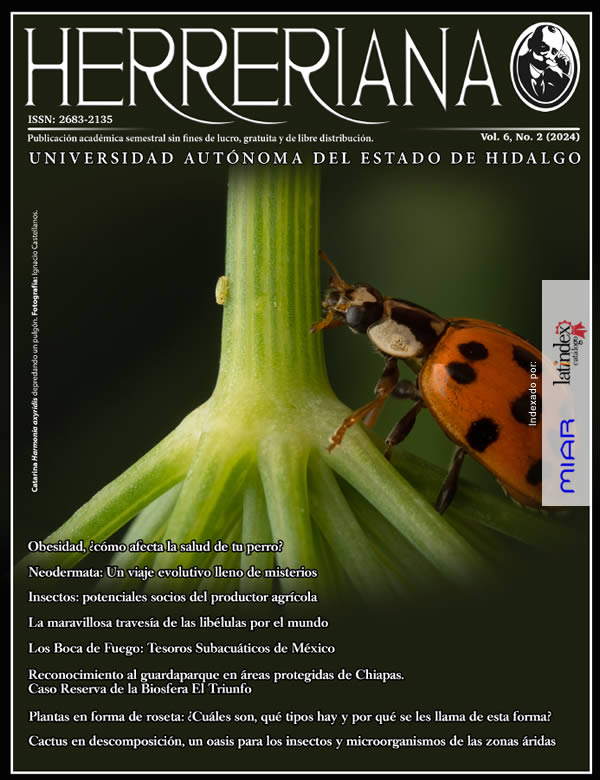Insectos: potenciales socios del productor agrícola
DOI:
https://doi.org/10.29057/h.v6i2.12534Palabras clave:
Biodiversidad de insectos, Conservación, Servicios ecosistémicos, Manejo agrícolaResumen
Los insectos encuentran en los cultivos agrícolas importantes recursos de alimentación, hábitat y lugares para su reproducción. Los cultivos, por su parte, también se benefician de la presencia de insectos. Aunque comúnmente se les identifica como nocivos, muchos insectos llevan a cabo contribuciones para el correcto funcionamiento del cultivo, como la polinización y el control de plagas. La actual disminución en las poblaciones de insectos provoca pérdidas en las funciones que estos organismos realizan en los agroecosistemas. Por ello, es necesario implementar herramientas sociales, agrícolas y legales que aseguren poblaciones viables de insectos.
Descargas
Información de Publicación
Perfiles de revisores N/D
Declaraciones del autor
Indexado en
- Sociedad académica
- N/D
- Editora:
- Universidad Autónoma del Estado de Hidalgo
Citas
Albrecht, M., Kleijn, D., Williams, N. M., Tschumi, M., Blaauw, B. R., Bommarco, R., ... y Sutter, L. (2020). The effectiveness of flower strips and hedgerows on pest control, pollination services and crop yield: a quantitative synthesis. Ecology Letters, 23(10), 1488-1498.
Almdal, C.D., y Costamagna, A.C. (2023). Annual crops contribute more predators than perennial habitats during an aphid outbreak. Insects, 14, 624.
Chacón, M., y Harvey, C.A. (2006). Live fences and landscape connectivity in a Neotropical agricultural landscape. Agroforestry Systems, 68, 15-26.
Díaz, S., Pascual, U., Stenseke, M., Martínez-López, B., Watson, R.T., Molnár, Z., Hill, R., Chan, K.M.A., Baste, I.A., Brauman, K.A., … y Shirayama, Y. (2018). Assessing nature’s contributions to people. Science, 359, 270–272.
Escobar-Ibáñez, J. F., Hernández-Cumplido, J., Rodríguez, W. D., Saldaña-Vázquez, R. A., y Zamora-Gutiérrez, V. (2023). Mexican fauna in agroecosystems: Challenges, opportunities and future directions. In: Jones, R.W., C. P. Ornelas-García, R. Pineda-López y F. Álvarez (Eds.), Mexican fauna in the Anthropocene (pp. 333-356). Springer International Publishing.
Gómez, B. G., del Val de Gortari, E., y Jones, R. W. (2023). Mexican insects in the Anthropocene. In: Jones, R.W., C. P. Ornelas-García, R. Pineda-López y F. Álvarez (Eds.), Mexican fauna in the Anthropocene (pp. 47-65). Springer International Publishing.
Gómez-Otamendi, E., Ortiz-Arteaga, Y., Ávila-Gómez, E. S., Pérez-Toledo, G., Valenzuela, J., y Moreno, C. E. (2018). Diversidad de hormigas epigeas en cultivos de nopal tunero (Opuntia albicarpa) y matorrales de Opuntia spp. del estado de Hidalgo, México. Revista Mexicana de Biodiversidad, 89(2), 454-465.
Haan, N. L., Iuliano, B. G., Gratton, C., y Landis, D. A. (2021). Designing agricultural landscapes for arthropod-based ecosystem services in North America. Advances in Ecological Research, 64, 191-250.
IPBES: Potts, S. G., Imperatriz-Fonseca, V., Ngo, H. T., Biesmeijer, J. C., Breeze, T. D., Dicks, L. V., ... y Viana, B. F. (2016). Summary for policymakers of the assessment report of the Intergovernmental Science-Policy Platform on Biodiversity and Ecosystem Services on pollinators, pollination and food production. Secretariat of the Intergovernmental Science-Policy Platform on Biodiversity and Ecosystem Services, Alemania.
Jones, R. W., Bernal, J. S., del Val de Gortari, E., y Sánchez-Reyes, U. J. (2023). Origins and coadaptation of insect pests from wild to domesticated host plants: examples from maize, cotton, and prickly pear cactus. In: Jones, R.W., C. P. Ornelas-García, R. Pineda-López y F. Álvarez (Eds.), Mexican fauna in the Anthropocene (pp. 549-567). Springer International Publishing.
Keeley, A. T., Fremier, A. K., Goertler, P. A., Huber, P. R., Sturrock, A. M., Bashevkin, S. M., ... y Stahl, A. T. (2022). Governing ecological connectivity in cross-scale dependent systems. BioScience, 72(4), 372-386.
Li, G., Yu, C., Shen, P., Hou, Y., Ren, Z., Li, N., ... y Wen, X. (2024). Crop diversification promotes soil aggregation and carbon accumulation in global agroecosystems: A meta-analysis. Journal of Environmental Management, 350, 119661.
Lichtenberg, E. M., Kennedy, C. M., Kremen, C., Batary, P., Berendse, F., Bommarco, R., ... y Crowder, D. W. (2017). A global synthesis of the effects of diversified farming systems on arthropod diversity within fields and across agricultural landscapes. Global Change Biology, 23(11), 4946-4957.
Mohamed, A., DeClerck, F., Verburg, P. H., Obura, D., Abrams, J. F., Zafra-Calvo, N., ... y Stewart-Koster, B. (2024). Securing Nature’s Contributions to People requires at least 20%–25%(semi-) natural habitat in human-modified landscapes. One Earth, 7(1), 59-71.
Redlich, S., Martin, E. A., y Steffan-Dewenter, I. (2018). Landscape-level crop diversity benefits biological pest control. Journal of Applied Ecology, 55, 2419–2428.
Solís-Montero, L., del Coro Arizmendi, M., de Castro Dubernard, A. M., Vergara, C. H., Díaz, M. Á. G., & Vandame, R. (2023). Pollination by wild and managed animal vectors. In: Jones, R.W., C. P. Ornelas-García, R. Pineda-López y F. Álvarez (Eds.), Mexican fauna in the Anthropocene (pp. 527-548). Springer International Publishing.
Wagner, D. L. (2020). Insect declines in the Anthropocene. Annual Review of Entomology, 65, 457-480.


















